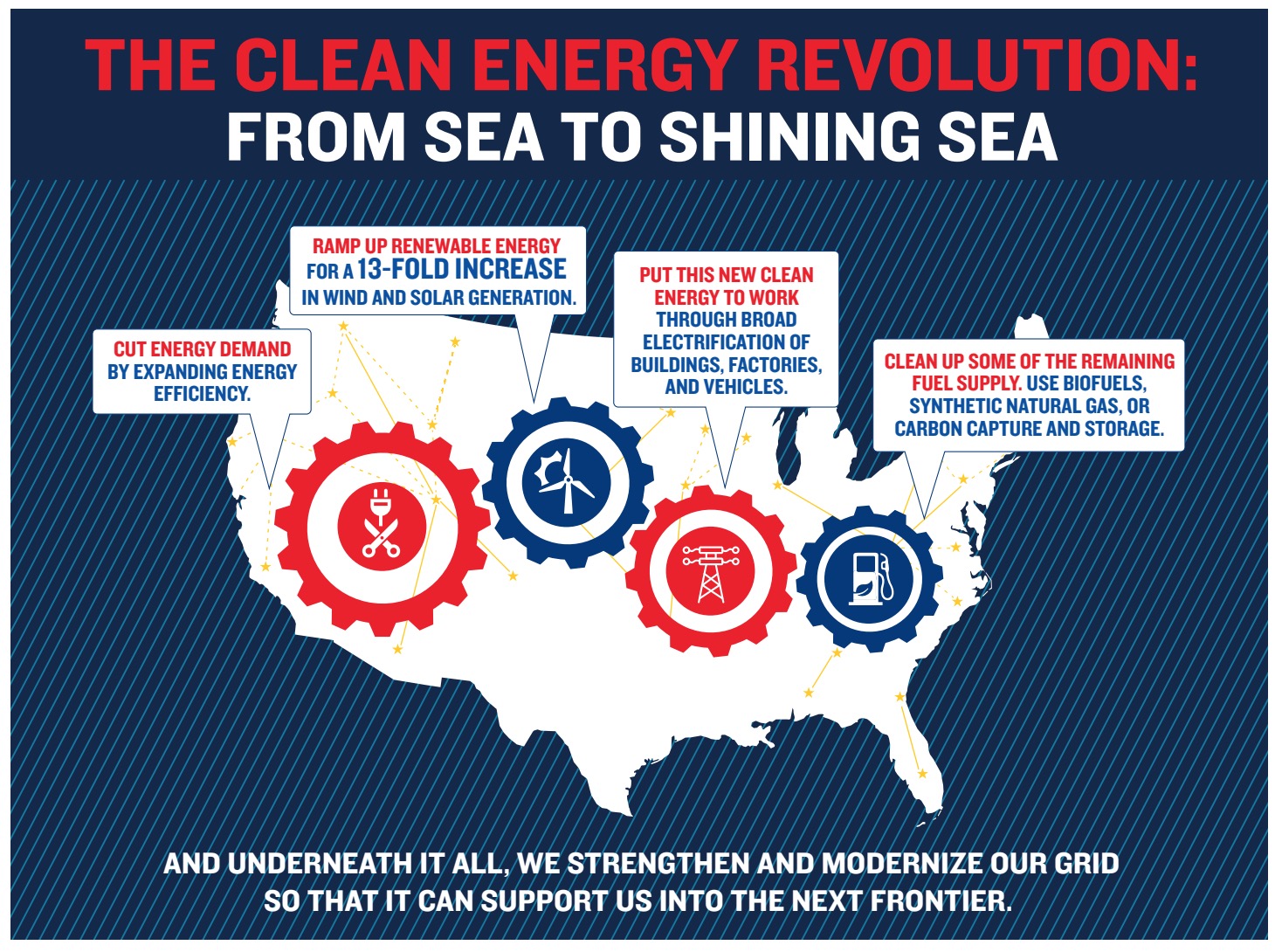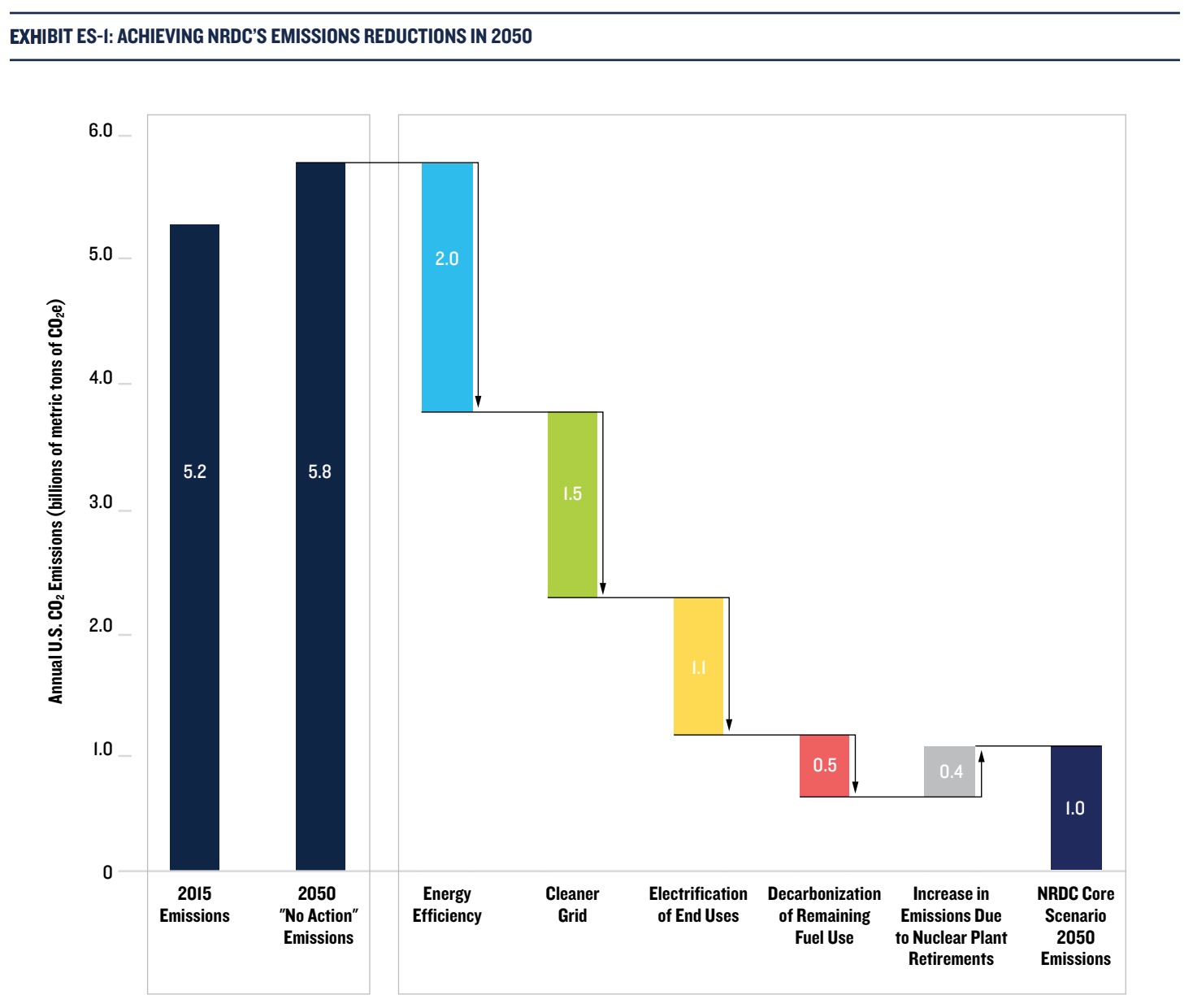NATURAL RESOURCES DEFENSE COUNCIL
Executive Summary
 To stave off the worst impacts of climate change, the world must limit warming to no more than 2 degrees Celsius above preindustrial temperatures. The Intergovernmental Panel on Climate Change (IPCC) says this will require developed countries—especially the United States as the world’s second-largest emitter—to cut their greenhouse gas (GHG) pollution by at least 80 percent by 2050, relative to 1990 emissions levels. The Natural Resources Defense Council (NRDC) partnered with the internationally recognized consultant group Energy + Environmental Economics (E3) to determine whether, and how, the United States could achieve this target.
To stave off the worst impacts of climate change, the world must limit warming to no more than 2 degrees Celsius above preindustrial temperatures. The Intergovernmental Panel on Climate Change (IPCC) says this will require developed countries—especially the United States as the world’s second-largest emitter—to cut their greenhouse gas (GHG) pollution by at least 80 percent by 2050, relative to 1990 emissions levels. The Natural Resources Defense Council (NRDC) partnered with the internationally recognized consultant group Energy + Environmental Economics (E3) to determine whether, and how, the United States could achieve this target.
NRDC’s groundbreaking analysis demonstrates clearly that with bold action on energy efficiency, renewable energy, electrification of vehicles and buildings with clean power, and electric grid enhancements, the United States can reach its 80 percent by 2050 climate goal. Moreover, we can get there at a much lower cost than any comparable study predicts.
Between 2015 and 2050, our plan’s costs are just 1 percent more than current U.S. energy costs, but deliver benefits 7 times greater than these costs. This translates to average costs of $22 billion a year and more than $154 billion a year in environmental benefits—in extreme weather, heat waves, and climate-induced illnesses avoided. If we include resulting additional health advantages, the net benefits would be even greater. It’s notable that NRDC’s pathway incurs low additional costs cumulatively by 2050 compared to a scenario in which no action is taken, but costs less in 2050, and may be the lowest-cost option beyond 2050. The additional expense arises from more up-front capital investments in clean and efficient power, appliances, and vehicles. But these technology investments result in significant and growing fuel savings that help offset the incremental costs over time. In fact, our scenario costs $30 billion less in 2050 than a no-action scenario. Lastly, while we did not model post-2050, our approach may be the least-cost option beyond 2050, thanks to the continuing fuel savings. Furthermore, there is no need for technological breakthroughs—we have the tools now. The United States can cost-effectively reduce GHG emissions with proven clean energy solutions, most of which are deployed at commercial scale today.
While other studies also conclude that an 80 percent emissions reduction by 2050 is feasible, our report breaks new ground by combining more aggressive—but achievable—assumptions on the potential to scale up energy efficiency, renewable energy, and clean electrification, with a more robust technical analysis incorporating grid reliability impacts. Our modeling also maximizes the co-benefits of energy efficiency (e.g., consumer bill reduction, reduced stress on the electricity grid, reduced air and water pollution, and fewer land use impacts). The modeling in other reports relies more on costlier or riskier technologies such as biomass or nuclear, or those currently deployed at a much lower scale like carbon capture and storage (CCS), to help meet U.S. climate objectives. NRDC’s study reveals new insights into what we believe to be a better, safer way to achieve America’s deep decarbonization goal, strengthening our grid and economy.
Since we began our analysis, President Trump announced his intention to withdraw the United States from the global Paris Climate Agreement, which pledges to limit the increase in global warming to well below 2 degrees (Celsius) while making best efforts to keep it beneath 1.5 degrees. Even if the federal government defaults on climate action for a period of time, it is essential that we continue to pursue aggressive emissions reductions to rein in runaway climate change. The efforts of state and local governments and businesses are even more crucial now, and fortunately there has been encouraging progress on that front.
Key Findings
Our analysis shows that expanding proven clean energy solutions—most of which are already deployed at commercial scale—can reduce U.S. GHG emissions across the entire economy by 80 percent by 2050. Under our NRDC Core Scenario, the United States will:
Implement energy efficiency technologies and system-wide approaches to reduce total U.S. energy demand by 40 percent (compared with our reference case in which America’s energy system evolves as it has historically). These reductions are achieved by aggressive efficiency improvements in buildings, factories, appliances, and vehicles based on what multiple, peer-reviewed sources have determined is feasible. New homes and office buildings would conform to much more stringent building energy codes, existing buildings undergo energy-saving improvements, the efficiency of appliances and equipment continues to increase, and the United States universally adopts light-emitting diode (LED) lighting in the buildings sector, helping consumers save energy and money while reducing the nation’s carbon footprint. The industrial sector also must make significant investments in efficiency, ultimately achieving sector-wide energy savings in line with those already attained by some leading industrial players. Lastly, passenger vehicles continue to become more efficient, with the gasoline vehicle fleet achieving an average fuel economy of around 80 miles per gallon (mpg) by 2050 (exceeding 100 mpg in gasoline equivalents if electric cars are included). This is accompanied by about 25 percent reduction in annual average passenger vehicle-miles traveled (VMT). These levels of energy efficiency require multiple, complementary efficiency investments that can be driven by federal, state, and local policies and standards, in coordination with businesses and communities.
Significantly expand renewable energy, like wind and solar, to generate more than 70 percent of our electricity supply by 2050, compared with today’s 8 percent from wind and solar. This will require a sizable increase in large-scale renewable energy facilities. Distributed (locally generated) renewable power production also can play a significant role. While ambitious, this expansion is achievable given the dizzying pace of U.S. renewable energy development amid steep price declines. For example, the costs of solar modules, the building blocks of photovoltaic panels, have declined by 80 percent in less than a decade, and average long-term power purchase contracts for wind have plummeted from $70 per megawatt-hour (MWh) in 2009 to less than $20 per MWh in 2016. Even as the federal renewable energy tax credits phase out, analysts expect solar and wind to become the lowest-cost form of new power by 2023 and to be less expensive than even existing fossil generation by 2027 nationwide. (It is already cheaper in some U.S. locations.) This buildout also is in line with other peer-reviewed modeling and government reports.
Employ the resulting near-zero-carbon electricity to the greatest practical extent to directly displace fossil fuels in transportation, residential and commercial buildings, and industry. By 2050, electricity produced largely from renewable resources could supply up to 45 percent of U.S. energy needs, up from just one-fifth today. Although this transformation is in its early stages, recent progress includes more than a half-million electric or hybrid cars on America’s roads. While our analysis electrifies a substantial portion of the economy, customer preferences and technological hurdles also were incorporated. This results in a scenario with more minimal electrification of some items, such as gas stoves, long-distance freight trucks, and the most energy-intensive industries. Electrification technologies result in an additional 10 percent reduction, approximately, of overall energy demand, bringing the total energy demand reduction to about 50 percent.
Decarbonize some of the remaining fuel use, mainly in transportation and industry. For applications that would be difficult to directly electrify (e.g., airplanes or long-haul trucks), we will need to replace oil or natural gas with decarbonized alternative fuels, derived from sustainable biomass or synthetic gas, and utilize carbon capture technologies to reduce the emissions footprint of these sub-sectors. Such strategies will contribute a vital 10 percent of emissions reductions.
Our analysis demonstrates that the projected level of renewable energy resources can be reliably integrated into the U.S. electricity grid, but it is critical that we modernize and expand it. The grid needs to be updated no matter what the future U.S. energy system looks like, as most of it was built more than 40 years ago and it is vulnerable to extreme weather events. Prioritizing grid investments that better accommodate large-scale renewable energy generation, distributed energy resources, storage technologies, and flexible demand patterns will ensure the biggest bang for our buck. Achieving a clean electric grid will require transmission and distribution infrastructure investments, expanded grid-oversight regions, reforms to energy market rules and operations, improved operational practices, advanced forecasting, and demand-side upgrades, as well as mechanisms that better utilize and value these clean energy solutions. These investments also can better optimize energy supply and demand, mitigating the incremental costs of an expanded clean electric transmission system by hundreds of billions of dollars.
Our four clean energy drivers, supported by a modernized grid, would reduce emissions to 1 billion metric tons compared to the approximately 5.8 billion metric tons anticipated if no action is taken, as shown in Exhibit ES-1.
Download full version (PDF): America’s Clean Energy Frontier
About the Natural Resources Defense Council
www.nrdc.org
NRDC works to safeguard the earth—its people, its plants and animals, and the natural systems on which all life depends. We combine the power of more than two million members and online activists with the expertise of some 500 scientists, lawyers, and policy advocates across the globe to ensure the rights of all people to the air, the water, and the wild.
Tags: Emissions, Natural Resources Defense Council, NRDC, Paris Agreement








 RSS Feed
RSS Feed